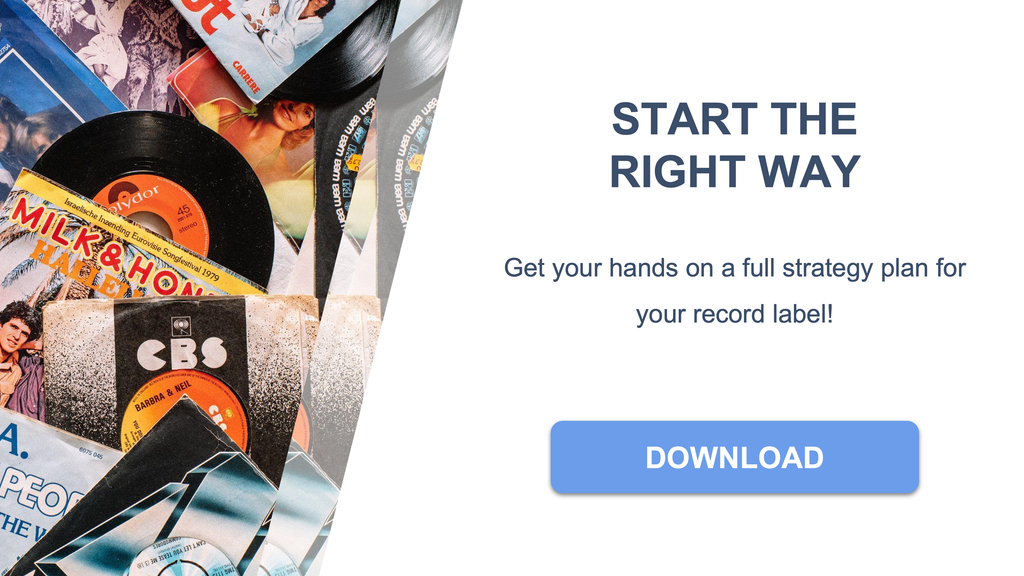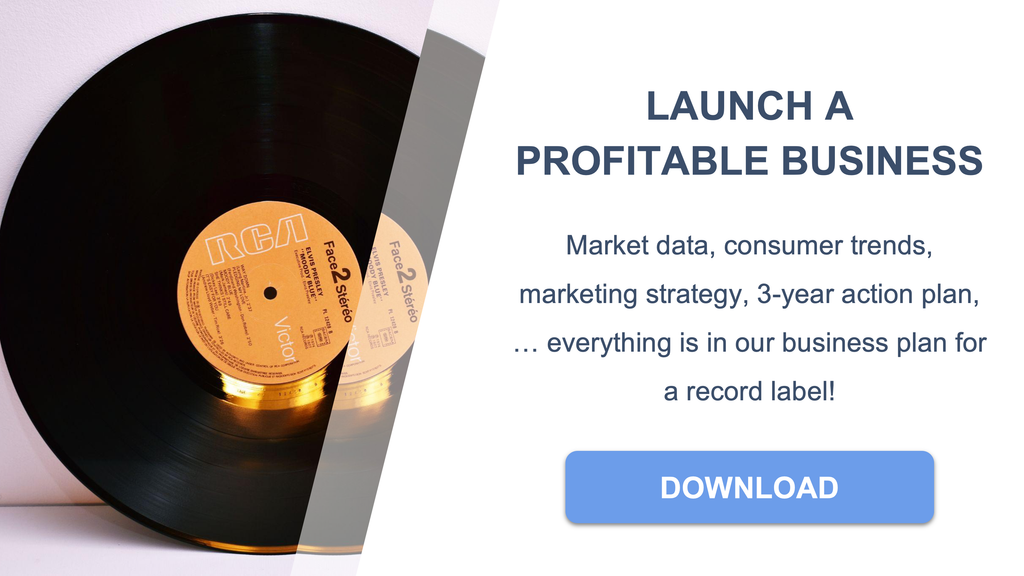
Get a watermark-free, fully customizable SWOT analysis in our business plan for a record label
We've drafted tons of business plans for record labels and, far too often, business owners neglect to dedicate time and thought to crafting a strategic vision for their new project.
It's mainly because they lack the right tools and frameworks. The SWOT analysis is one of them.
What is it? Should you make a SWOT for your record label?
A SWOT analysis is a vital framework for strategic planning in various industries, including the music business, particularly for record labels. This tool helps you assess your label's Strengths, Weaknesses, Opportunities, and Threats in a structured and comprehensive way.
Originally designed to offer a systematic approach for businesses to understand both their internal dynamics and external circumstances, the SWOT analysis is especially beneficial in the fast-paced and ever-evolving music industry.
As someone involved in running or considering starting a record label, performing a SWOT analysis can be incredibly advantageous. It provides insight into what your label excels at (strengths), areas that need improvement (weaknesses), potential growth paths or market trends you can capitalize on (opportunities), and external challenges you may face (threats).
For example, your label's strengths might be a strong artist roster or exclusive distribution channels, whereas weaknesses could include limited financial resources or a lack of brand recognition. Opportunities could emerge from emerging music genres or digital streaming platforms, while threats might come from industry changes or competitive labels.
Conducting a SWOT analysis is particularly useful when you're launching a new label, planning a major shift in your strategy, or tackling industry challenges. It offers a holistic view of your business within the context of the wider music industry.
By identifying and understanding these four components, you can make strategic decisions, set priorities, and formulate plans that leverage your strengths, address your weaknesses, and prepare for external impacts.
If you're embarking on a new record label venture, a SWOT analysis is not just beneficial; it's crucial. It helps you pinpoint your unique advantages, areas that require more focus or development, and external factors to be mindful of.
While this analysis doesn't assure success, it significantly boosts your chances by providing a clear and focused roadmap for your business.
Finally, if you're writing a business plan for your record label, then you should definitely draft a SWOT analysis.
How do you write a SWOT analysis for your record label?
Filling out a SWOT analysis for a record label you're planning to launch can be a bit daunting, especially when you're trying to assess future strengths, weaknesses, opportunities, and threats in the music industry.
Engaging in industry research and analyzing music trends are crucial steps. This approach provides valuable data about current music preferences, emerging genres, and the overall market competition.
Networking with music industry professionals, artists, and other label owners can also offer insights you might not find in industry reports. Their experiences can shed light on real-world challenges and opportunities in the music business.
Remember, the purpose of a SWOT analysis is to equip you with a strategic perspective rather than to foresee the future precisely.
Strengths
Consider your unique offerings. Perhaps your record label focuses on a genre that's gaining popularity, or you have connections with well-known artists. Your strength could also be in innovative marketing strategies or a team with extensive experience in music production and artist management.
These internal factors can set your label apart in the competitive music industry.
Weaknesses
Honestly assessing weaknesses is vital. You might have limited resources for artist promotion, or you're new to the industry and lack established connections. There could be a high level of competition in your chosen genre, or perhaps your label is heavily invested in a musical trend that's fading.
Identifying these areas helps you plan better and seek the necessary support or partnerships.
Opportunities
Opportunities in the music industry are often external and can provide significant advantages. This could include a rising demand for a specific music genre that your label specializes in, potential collaborations with influential media platforms, or innovative distribution channels like streaming services.
Emerging technology trends in music production and distribution could also present opportunities for your label to innovate and stand out.
Threats
Threats are external factors that could challenge your label. These might include shifts in music consumption patterns, stringent copyright laws, or economic factors that affect consumers' spending on entertainment. The rise of independent artists who bypass traditional record labels is also a potential threat, as is intense competition from established labels.
Being aware of these threats helps in preparing strategies to mitigate their impact.

Examples of Strengths, Weaknesses, Opportunities and Threats for the SWOT of a record label
These strengths and opportunities can be leveraged to improve the profitability of your record label.
| Strengths | Weaknesses | Opportunities | Threats |
|---|---|---|---|
| Strong roster of talented artists | Limited financial resources | Emerging music streaming platforms | Intense competition in the industry |
| Established brand and reputation | Dependence on a few key artists | Global expansion possibilities | Changing consumer music preferences |
| Effective marketing and promotion capabilities | Lack of diversity in music genres | Partnerships with independent labels | Piracy and illegal downloads |
| Access to top-notch recording studios | Inefficient royalty tracking and payments | Growth of live music events | Fluctuating music sales |
| Strong online presence and social media following | Limited distribution channels | Technological advancements in music production | Political and regulatory changes |
| Experienced and talented A&R team | Difficulty in retaining top talent | Collaboration opportunities with emerging artists | Economic downturns affecting music consumption |
| Exclusive rights to popular music catalogs | Inadequate digital marketing strategy | Investment in music licensing for TV and film | Market saturation in certain music genres |
| Strong relationships with music producers | Limited geographical reach | Streaming platforms' algorithmic playlists | Inflation and rising production costs |
| Dedicated fan base for specific genres | Overreliance on traditional sales channels | Market demand for vinyl records | Cybersecurity threats and data breaches |
| In-house music production and recording facilities | High artist turnover | Opportunity to sign emerging international artists | Streaming service exclusive deals |
More SWOT analysis examples for a record label
If you're creating your own SWOT analysis, these examples should be useful. For more in-depth information, you can access and download our business plan for a record label.
A SWOT analysis for a Major Record Label
Strengths
A major record label benefits from substantial financial resources and a vast distribution network, enabling wide-reaching promotion and distribution of music. It has established relationships with media, influencers, and other key industry players, enhancing its marketing and promotional capabilities. The label's diverse roster of well-known artists helps in attracting new talent and maintaining a strong market presence.
Weaknesses
Large record labels often face challenges in rapidly adapting to industry changes due to their size. They might be less willing to take risks on unconventional artists or innovative music styles. The focus on mainstream commercial success can sometimes lead to a lack of artistic diversity and creativity.
Opportunities
Investing in emerging digital platforms and technologies like music streaming services can open up new revenue streams. Collaborating with artists from different genres or countries can help in tapping into new markets and demographics. The label can also venture into organizing large-scale music events and festivals.
Threats
The rise of independent labels and self-publishing platforms poses a significant threat by offering artists more control over their music and earnings. Changes in consumer preferences towards more niche and independent music can impact the label's market dominance. Piracy and copyright infringement continue to be major concerns.
A SWOT analysis for an Independent Record Label
Strengths
Independent labels are known for their artistic freedom and flexibility, attracting innovative and niche artists. They often have a dedicated, loyal fan base and a strong identity within certain music communities. These labels are typically more agile and responsive to industry trends and changes.
Weaknesses
Limited financial resources can hinder the label's promotional and distribution capabilities. Independent labels often struggle with less visibility compared to major labels. They also have fewer connections in the industry, which can impact their marketing and networking efforts.
Opportunities
There's an opportunity to capitalize on the growing demand for unique and diverse music offerings. Collaborating with digital platforms and utilizing social media for marketing can significantly increase reach. Partnering with other independent entities for events or compilations can expand their audience base.
Threats
Competition from both major labels and a plethora of other independent labels is intense. Financial instability can be a significant issue, especially when trying to compete with the marketing and distribution power of larger labels. The rapid pace of change in music consumption habits requires constant adaptation.
A SWOT analysis for a Niche Genre Record Label
Strengths
A niche genre record label stands out for its specialization and expertise in a specific music genre, attracting a dedicated fan base. It often has strong relationships with artists within that genre and a deep understanding of the market and audience preferences. These labels can create a strong community around their brand.
Weaknesses
The primary weakness is the limited market size, as it caters to a specific genre. There's a risk of becoming too insular and missing broader industry trends. The label may also struggle to attract a wider audience beyond its specific niche.
Opportunities
Expanding the label's influence by organizing genre-specific events or festivals can attract new fans. Collaborating with artists from similar or complementary genres can broaden the appeal. Utilizing digital platforms to reach international audiences can also be beneficial.
Threats
Changes in musical trends and tastes pose a risk, especially if the niche becomes less popular. Competition from other labels within the same genre can be intense. There's also a risk of key artists leaving the label for broader opportunities, impacting its reputation and appeal.

